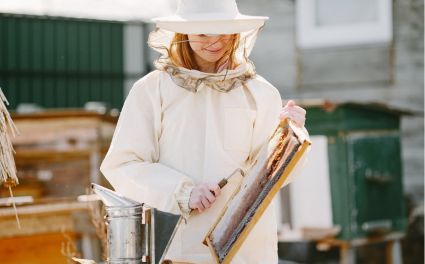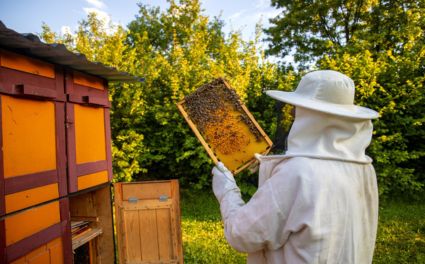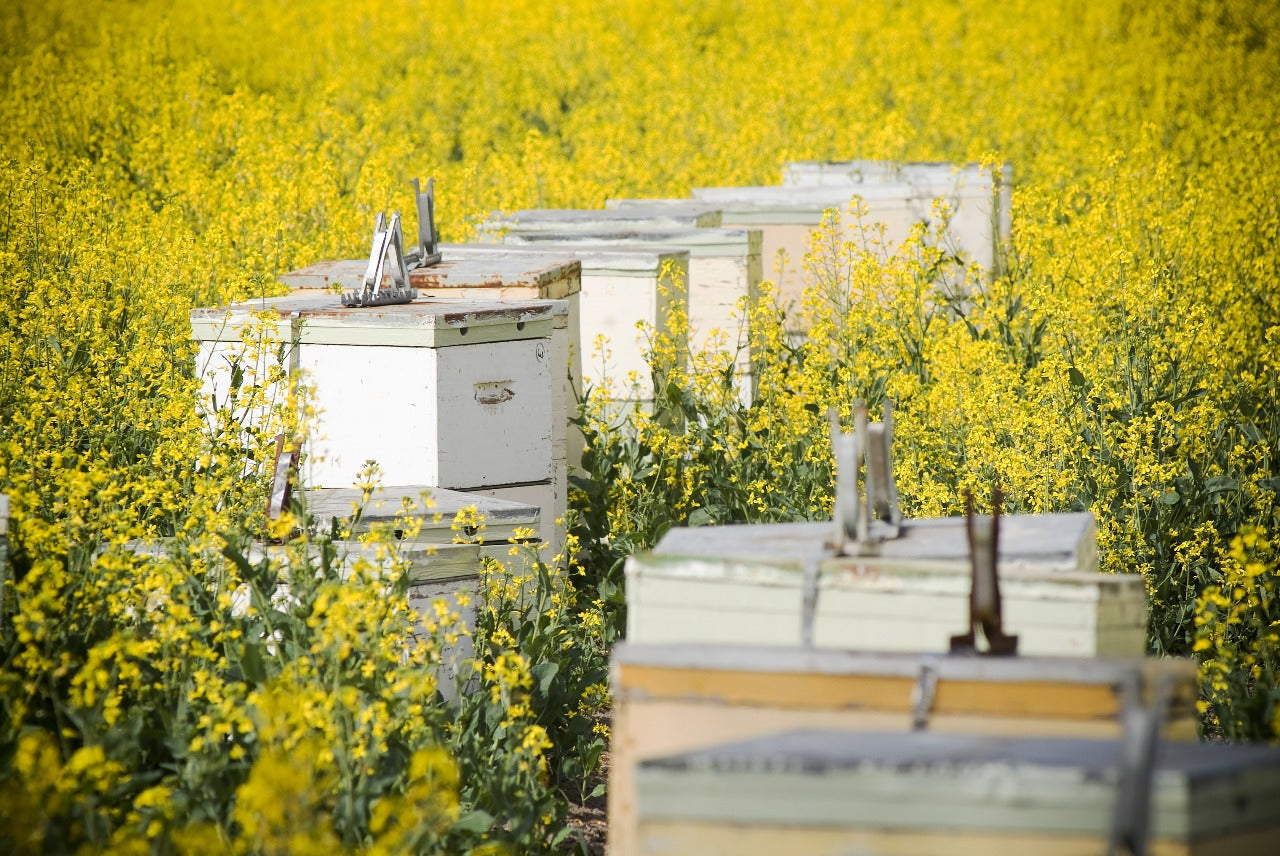Painting a beehive isn’t just about making it look pretty — it’s a practical step that protects the wood, extends the hive’s lifespan, and keeps your honey bees comfortable in all weather conditions. A properly painted beehive shields against moisture, rot, and sunlight, reducing maintenance while adding a touch of personality to your apiary.
This detailed guide explains how to paint a beehive the right way, the best paints to use, and important safety precautions every beekeeper should know. Whether you’re new to the craft or a seasoned apiarist, mastering this process will ensure both durability and style for your hives.
🧰 Preparation: Getting Your Beehive Ready
Before you pick up a brush, preparation is key to a perfect paint job.
1. Choosing the Right Paint and Primer
Select a non-toxic, water-based acrylic paint designed for outdoor wooden surfaces. These paints are durable, eco-friendly, and safe for bees once fully cured. Avoid oil-based paints or any containing lead, as they may release harmful fumes.
A quality primer ensures paint adhesion and prevents cracking over time. Opt for an exterior-grade primer that’s compatible with your chosen paint type.
While preparing, always wear proper safety gear — beekeeping gloves to avoid skin irritation, and a beekeeping veils to protect yourself from curious bees if the hive is nearby.
2. Cleaning and Sanding the Beehive
Before painting, thoroughly clean the hive surfaces to remove dirt and residue. Use a mild soap solution and a soft brush, then let the wood dry completely.
Next, sand the entire hive with fine-grit sandpaper. This smooths the surface, helping the primer and paint bond evenly. Be gentle around joints or corners to avoid damaging the structure.
If you’re painting used equipment, make sure there’s no wax residue — bees are sensitive to smell and may reject their hive if foreign odors linger.
(Also read: How Do Bees Make Hives?)
3. Picking the Perfect Painting Spot
Choose a well-ventilated, shaded area for painting. Direct sunlight can cause the paint to dry too fast, leading to cracks. Proper airflow also helps fumes dissipate quickly, ensuring a safer environment for both you and your bees.
Wearing protective clothing like beekeeping suits or lightweight beekeeping jackets is recommended to prevent accidental stings during outdoor hive work. For family projects, beekeeping kids suits ensure younger helpers stay safe too.

🖌️ Priming: Building a Solid Foundation
Applying a primer is a vital step before painting a beehive. It seals the wood and creates a strong surface for the paint to cling to.
Use a brush or roller to spread the primer evenly, making sure to cover all edges and joints. Don’t forget small crevices where water might seep in. Once done, allow the primer to dry completely—ideally for 24 hours.
Avoid rushing this step; a well-dried primer enhances durability and prevents peeling. After priming, lightly sand the surface once more to smooth out any raised fibers.
🎨 Painting the Beehive: Technique and Tips
Now comes the fun part — bringing your hive to life!
Applying the First Coat
Using a clean brush or foam roller, apply a thin and even layer of paint. Light coats allow for better adhesion and prevent drips or streaks. Focus on the outer surfaces only — never paint the inside of the hive, as paint fumes can harm the bees.
Drying and Layering
Let each coat dry fully before applying another. Two or three coats are often sufficient for full protection. Be patient; hasty work can lead to uneven finishes and peeling.
If you’re painting multiple hives, consider using distinct color patterns to help bees identify their homes more easily. Bees rely on visual cues, and unique designs reduce drifting between colonies.
(Also read: How Do Beehives Work?)
Choosing Beehive Colors
-
Light colors like white, cream, or pastel shades reflect sunlight, keeping hives cool in hot weather.
-
Darker tones can help absorb warmth in colder regions.
-
For fun personalization, try soft blues, greens, or even decorative designs using pink bee suits to match your style!
Whatever color you choose, ensure it blends naturally with the environment and doesn’t confuse your bees.
🐝 Detailing and Decoration
Once the main paint job is done, consider adding simple decorative touches. Some beekeepers use stencils, decals, or hand-painted patterns for uniqueness. You might also mark hive numbers or your logo for easy identification.
Just make sure decorations are minimal and safe — no raised surfaces or rough finishes that might trap moisture. Always prioritize functionality and the bees’ comfort over aesthetics.
When decorating near the hive, use protective wear like beekeeping trousers and beekeeping ankle protection to avoid stings while working close to colonies.
(Also read: The Secret Lives of Bees)
🌬️ Drying and Curing the Painted Hive
After painting, let the hive dry in a shaded, airy place. Avoid humid areas, as moisture can cause bubbling or uneven drying.
Allow several days for the paint to fully cure — this ensures no residual odors remain that could disturb your bees. A simple touch test (making sure no stickiness remains) can confirm readiness.
Never return the bees to a freshly painted hive until all fumes are gone. To keep your bees safe during this time, relocate them temporarily or use another bee nest if available.
🔧 Final Touches & Inspection
Once the paint has cured, inspect your hive thoroughly:
-
Check for missed spots or uneven finishes.
-
Apply minor touch-ups if necessary.
-
Ensure all joints and corners are sealed properly to prevent moisture damage.
Before reintroducing your bees, let the hive air out for an additional day. Bees are sensitive to smell, so eliminating any trace of paint odor promotes a healthy, stress-free environment.
🧤 Safety and Protective Tips for Beekeepers
Painting is best done while wearing breathable protection, especially around active apiaries. OZ Armour offers durable, lightweight beekeeping suits and beekeeping gloves that safeguard against stings while allowing easy movement.
If wasps or other insects linger nearby, remember that even bee suits can help. Learn more in Do Bee Suits Protect from Wasps?
For beginners, Learn Beekeeping sections provide essential guides on setting up hives, maintaining colonies, and caring for honey bees.
🌿 Eco-Friendly Beekeeping
Sustainable beekeeping goes hand in hand with hive maintenance. Choose environmentally friendly materials whenever possible — non-toxic paints, minimal plastic tools, and durable Beekeeping Equipments that lasts for seasons.
A well-painted hive reflects your commitment to ethical practices and environmental care. It not only shelters your bees but also represents your dedication to responsible stewardship of nature.
(Related reads: Bumblebee vs Honeybee | Carpenter Bee vs Bumblebee)

🐝 Final Thoughts
Painting a beehive is a blend of artistry and science — it protects, beautifies, and supports the well-being of your bees. From selecting safe materials to proper drying and inspection, every step contributes to a stronger, more sustainable colony.
Be patient, use eco-safe paints, and always prioritize your bees’ comfort. A well-maintained hive encourages productivity and longevity — helping your honey bees thrive season after season.
As a trusted name in protective beekeeping apparel, OZ Armour continues to support beekeepers worldwide with advanced jackets, veils, gloves, and more — ensuring safety while you focus on your craft.
For more insights and tutorials, explore Read More Blogs About Beekeeping and discover inspiring stories on Learn Beekeeping.













